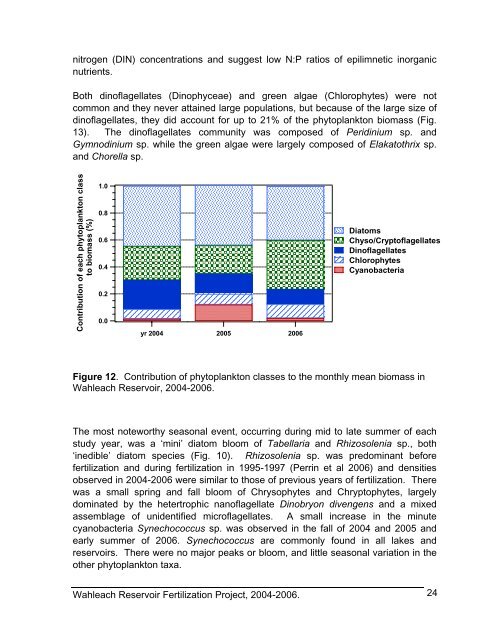Wahleach Project Water Use Plan Wahleach Reservoir ... - BC Hydro
Wahleach Project Water Use Plan Wahleach Reservoir ... - BC Hydro
Wahleach Project Water Use Plan Wahleach Reservoir ... - BC Hydro
Create successful ePaper yourself
Turn your PDF publications into a flip-book with our unique Google optimized e-Paper software.
nitrogen (DIN) concentrations and suggest low N:P ratios of epilimnetic inorganic<br />
nutrients.<br />
Both dinoflagellates (Dinophyceae) and green algae (Chlorophytes) were not<br />
common and they never attained large populations, but because of the large size of<br />
dinoflagellates, they did account for up to 21% of the phytoplankton biomass (Fig.<br />
13). The dinoflagellates community was composed of Peridinium sp. and<br />
Gymnodinium sp. while the green algae were largely composed of Elakatothrix sp.<br />
and Chorella sp.<br />
Contribution of each phytoplankton class<br />
to biomass (%)<br />
1.0<br />
0.8<br />
0.6<br />
0.4<br />
0.2<br />
0.0<br />
yr 2004 2005 2006<br />
Diatoms<br />
Chyso/Cryptoflagellates<br />
Dinoflagellates<br />
Chlorophytes<br />
Cyanobacteria<br />
Figure 12. Contribution of phytoplankton classes to the monthly mean biomass in<br />
<strong>Wahleach</strong> <strong>Reservoir</strong>, 2004-2006.<br />
The most noteworthy seasonal event, occurring during mid to late summer of each<br />
study year, was a ‘mini’ diatom bloom of Tabellaria and Rhizosolenia sp., both<br />
‘inedible’ diatom species (Fig. 10). Rhizosolenia sp. was predominant before<br />
fertilization and during fertilization in 1995-1997 (Perrin et al 2006) and densities<br />
observed in 2004-2006 were similar to those of previous years of fertilization. There<br />
was a small spring and fall bloom of Chrysophytes and Chryptophytes, largely<br />
dominated by the hetertrophic nanoflagellate Dinobryon divengens and a mixed<br />
assemblage of unidentified microflagellates. A small increase in the minute<br />
cyanobacteria Synechococcus sp. was observed in the fall of 2004 and 2005 and<br />
early summer of 2006. Synechococcus are commonly found in all lakes and<br />
reservoirs. There were no major peaks or bloom, and little seasonal variation in the<br />
other phytoplankton taxa.<br />
<strong>Wahleach</strong> <strong>Reservoir</strong> Fertilization <strong>Project</strong>, 2004-2006.<br />
24
















